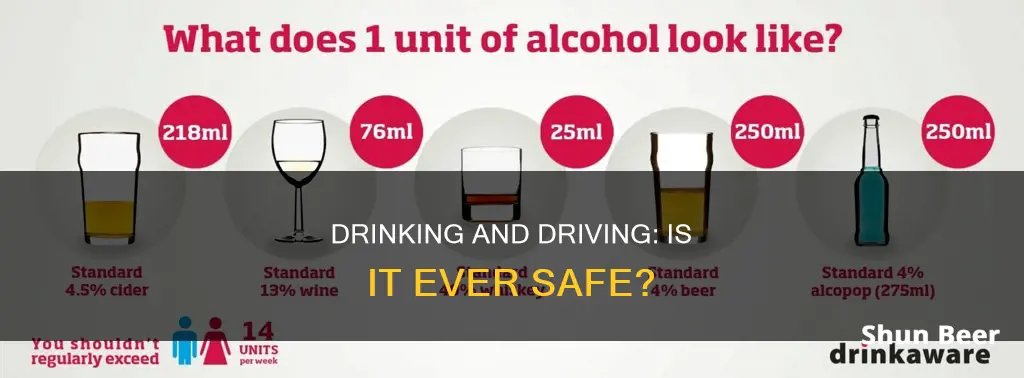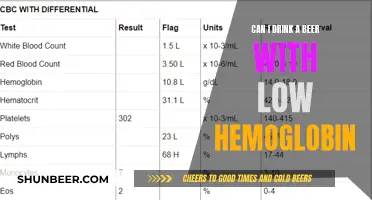
Drinking and driving is a highly debated topic, with varying opinions and regulations across the globe. While some countries have a zero-tolerance policy, allowing no alcohol in the system of drivers, others set a limit for Blood Alcohol Concentration (BAC) or Blood Alcohol Content. In most US states, the legal BAC limit is 0.08%, while Utah has set a stricter limit of 0.05%. Driving with a BAC level above these limits can result in DUI charges, fines, imprisonment, and license suspension.
The impact of alcohol on driving abilities varies across individuals due to factors such as body weight, height, medication, food intake, drinking speed, and tolerance. While some individuals might feel comfortable driving after a drink or two, it's important to recognize that even small amounts of alcohol can impair driving abilities and increase the risk of collisions. The safest option is to avoid driving after consuming any alcohol and explore alternative transportation methods.
| Characteristics | Values |
|---|---|
| Legal blood alcohol limit in the US | 0.08% |
| Legal blood alcohol limit in Utah | 0.05% |
| Legal blood alcohol limit in Australia | 0.05% |
| Blood alcohol level that doubles the likelihood of an accident | 0.05% |
| Blood alcohol level that increases the risk of an accident eightfold | Above 0.05% |
| Factors that affect alcohol's impact on the body | Type of drink, body characteristics, and time |
| Guidelines for men drinking alcohol in Australia | No more than two standard drinks in the first hour, followed by one standard drink every hour after that |
| Standard drink in Australia | 30ml of spirits, 285ml of beer, 375ml of low-alcohol beer, 100ml of wine, or 60ml of sherry or port |
| Effect of alcohol on the brain | Slows down brain activity |
| Effect of a 0.02% blood alcohol level | Hand shaking and inability to control lane position while driving |
| Effect of a 0.05% blood alcohol level | Impaired peripheral vision, impaired judgement of distances, and increased risk-taking |
What You'll Learn

How much alcohol is too much to drive?
The amount of alcohol that is too much to drive varies from person to person and depends on a number of factors. These include body weight, height, sex, metabolism, and whether the person has recently eaten. According to the California DMV, two drinks (12 oz, 5% beer) will make a male who weighs 140 pounds or less or a female who weighs 160 pounds or less legally drunk. However, some people may be over the limit after just one drink, and others may still be under the limit after three or four drinks.
In most U.S. states, the legal blood alcohol limit for driving is 0.08%. However, this varies from state to state, and in Utah, the limit is 0.05%. At a blood alcohol concentration (BAC) of 0.05%, a person is twice as likely to be involved in a collision compared to when they are sober. The risk increases dramatically beyond this limit. Therefore, it is generally recommended that people do not drive after consuming any alcohol.
In addition to the number of drinks consumed, the time over which they are consumed also matters. Drinking two drinks quickly will result in a higher BAC compared to drinking the same amount over a few hours. This is because the liver cannot process the alcohol quickly enough, leading to a higher concentration of alcohol in the bloodstream.
Other factors that can affect BAC include medication use, frequent alcohol consumption (which can lead to a higher tolerance), and lack of food intake before drinking. Personal breathalyzers can provide an estimate of BAC, but they may not always be accurate. Therefore, it is important to use other methods to assess sobriety before driving, such as how one feels and whether they can perform field sobriety tests.
The Frozen Beer Conundrum: To Drink or Not?
You may want to see also

How does alcohol affect driving abilities?
Alcohol is a depressant drug that slows down the activity of the central nervous system, including the brain. Even a small amount of alcohol can affect your driving ability. Here are some ways in which alcohol impairs your driving abilities:
Relaxation and Drowsiness
Alcohol causes feelings of relaxation and drowsiness, which may lead to falling asleep at the wheel. This can be extremely dangerous and increase the risk of accidents.
Reduced Reaction Times
Alcohol slows down your reflexes and decreases your ability to react to unexpected situations while driving. This includes slower visual reaction time, making it harder to detect and respond to roadway hazards.
Impaired Concentration and Vigilance
Alcohol affects your ability to focus and pay attention to the multiple tasks involved in driving, such as steering, maintaining speed, staying in your lane, and avoiding other vehicles.
Difficulty in Understanding Surroundings
Alcohol can make it difficult for you to understand what's happening around you, impairing your sensory perception and decision-making abilities. This can lead to misjudgments and risky behaviours while driving.
Multitasking Ability
Driving requires multitasking, such as keeping in your lane and monitoring other traffic. Alcohol consumption can impair your ability to perform multiple tasks simultaneously, increasing the risk of accidents.
Impaired Vision
Alcohol relaxes the muscles that control the eyes, causing blurred vision and slower visual reaction time. It also reduces peripheral vision, making it difficult for drunk drivers to see anything that isn't directly in front of them, including pedestrians, obstacles, and other vehicles.
Over-confidence and Risk-taking
Alcohol can lead to over-confidence and increased risk-taking behaviours. Drunk drivers may underestimate the dangers of the road and make impulsive decisions, endangering themselves and others.
It's important to note that the effects of alcohol on driving abilities can vary from person to person, depending on factors such as body weight, metabolism, medication, and food intake. However, the safest option is to refrain from drinking if you plan to drive. If you do choose to drink, it's crucial to monitor your alcohol consumption, ensure you stay within the legal blood alcohol concentration (BAC) limits, and consider alternative transportation options if you're unsure about your fitness to drive.
Beer Drinking and DTS: A Deadly Mix?
You may want to see also

What are the legal consequences of drinking and driving?
Drinking and driving is a serious offence that can have severe legal consequences. The legal repercussions of drinking and driving vary across different regions. In North Dakota, it is illegal to drive with a blood alcohol concentration (BAC) of over .08%. The penalties for a DUI offence in North Dakota include fines, imprisonment, and suspension of your license. The severity of these penalties increases for repeat offences. A fourth or subsequent DUI within 15 years is classified as a Class C felony, with harsher penalties including longer jail sentences and heavier fines of up to $10,000.
In Canada, impaired driving is the leading criminal cause of death and injury. The Criminal Code prohibits driving while impaired to any degree by drugs, alcohol, or a combination of both. The prohibited blood-alcohol concentration (BAC) is 80 milligrams or more of alcohol per 100 millilitres of blood. The penalties for impaired driving in Canada range from mandatory minimum fines to life imprisonment, depending on the severity of the offence and whether it is a repeated offence.
In Ontario, alcohol-impaired driving is one of the leading causes of death on the roads. If you are convicted of impaired driving in court, you can face additional fines, jail time, and licence suspension. The length of the suspension and the severity of the penalty increases with the number of convictions. A fourth conviction within 10 years results in a lifetime licence suspension with no possibility of reduction.
It is important to note that the legal consequences of drinking and driving can vary based on specific circumstances, such as the amount of alcohol or drugs in your system, your age, licence type, and the jurisdiction where the offence occurred.
Beer and Food: Virginia's Perfect Pairing Ratio
You may want to see also

What factors influence how alcohol affects a person?
There are many factors that influence how alcohol affects a person. Here are some key considerations:
Amount and Speed of Consumption
The amount of alcohol consumed and the speed of consumption are significant factors. The more alcohol consumed in a short period, the higher the Blood Alcohol Content (BAC). Drinking alcohol quickly can lead to a higher BAC compared to drinking the same amount over a longer period.
Biological and Genetic Factors
An individual's biology and genetics can play a role in how they are affected by alcohol. For example, women tend to have lower levels of alcohol dehydrogenase, the enzyme that metabolizes alcohol, leading to higher BAC levels. Additionally, women typically have a higher percentage of body fat, which further concentrates alcohol in the body.
People of Asian or Native American descent also tend to have reduced levels of alcohol dehydrogenase, causing alcohol to remain in the bloodstream longer.
Body Size and Composition
Body size and composition are important factors. Smaller individuals with lower body weight will generally become impaired more quickly as alcohol distributes throughout the body via the circulatory system, except in bone and fat tissue. A higher percentage of body fat increases the concentration of alcohol in the lean tissues.
Food Consumption
Consuming food, especially larger meals, before or while drinking can slow the absorption of alcohol into the bloodstream. This gives the liver more time to process the alcohol, reducing the peak blood alcohol concentration.
Carbonated Beverages
Carbonation speeds up alcohol absorption. Mixing alcohol with carbonated beverages, such as cola, or drinks like champagne and wine coolers, will result in faster absorption into the bloodstream.
Medication and Drug Use
Mixing alcohol with certain medications or drugs can have hazardous consequences. Over-the-counter drugs like aspirin, ibuprofen, and acetaminophen, as well as prescription medications, can impact the liver's ability to process alcohol, leading to hazardous side effects.
Stimulant drugs may give a false sense of energy and sobriety, while depressant drugs can enhance alcohol's effects.
Mental and Physical Health
An individual's mental and physical health can influence how alcohol affects them. Being stressed, anxious, depressed, tired, or sick can lower enzyme levels, enhance intoxication, and increase BAC levels.
Tolerance
Tolerance to alcohol can develop over time, leading to a false sense of coordination and control. However, it is important to note that tolerance does not change the BAC level, and even with a higher tolerance, individuals can still be impaired and should exercise caution, especially when it comes to activities like driving.
Beer and Xarelto: Is It Safe to Drink?
You may want to see also

What are the alternatives to drinking and driving?
Drinking and driving is illegal and dangerous. If you're planning to drink, it's always best to make alternative plans to get home. Here are some safe alternatives to drinking and driving:
Designated Driver
Appoint a designated driver when going out with friends. Choose someone you trust to refrain from drinking and who will be able to resist the temptation to consume alcohol. Make a clear plan before anyone starts drinking, and ensure that the designated driver remains completely sober.
Ridesharing Services
Ridesharing services such as Uber and Lyft offer a quick and efficient way to book a ride home. These services are widely available in most urban and suburban areas and can be easily accessed through mobile applications.
Taxi Services
Traditional taxi services are another reliable option. Taxis are typically easy to hail in urban areas and can also be booked in advance by calling a taxi company or using a mobile app.
Public Transportation
Take advantage of public transportation options such as buses, trains, subways, or trams. These options are usually available in most cities, even smaller ones, and can provide a cost-effective and environmentally friendly way to get home.
Local Community Programs
Look into local community programs such as Safe Rides or Tow-to-Go services. These initiatives, often run by volunteer or non-profit organizations, provide free or low-cost transportation for individuals who are too impaired to drive.
Stay Overnight
Whenever possible, plan to stay at a friend's place or book a nearby hotel or motel. This eliminates the need to drive entirely and ensures you have a safe place to stay until you are sober.
Remember, it's essential to prioritize safety over convenience. By choosing one of these alternatives, you can help protect yourself, your loved ones, and others on the road from the dangers of drinking and driving.
Beer Drinking and Liver Damage: What's the Link?
You may want to see also
Frequently asked questions
No, it is not safe to drink any amount of alcohol and then drive. Even one drink can impair your driving ability and increase the risk of collisions. The safest option is to avoid driving after consuming any alcohol.
The legal blood alcohol limit for driving varies by country and state. In most states in the US, the limit is 0.08%. However, in Utah, the limit is stricter at 0.05%.
Alcohol slows down brain activity, affecting your ability to focus, notice peripheral things, judge distances, and react to unexpected events. Even at the legal limit, your risk of being involved in a collision doubles compared to when you're sober.
Several factors determine how alcohol impacts you, including your body weight, height, sex, age, liver health, and whether you consumed food or medication along with the alcohol.
There are several alternatives to drinking and driving, such as designating a sober driver, using public transportation, ride-sharing services (e.g., Uber or Lyft), staying overnight, or taking a taxi.







